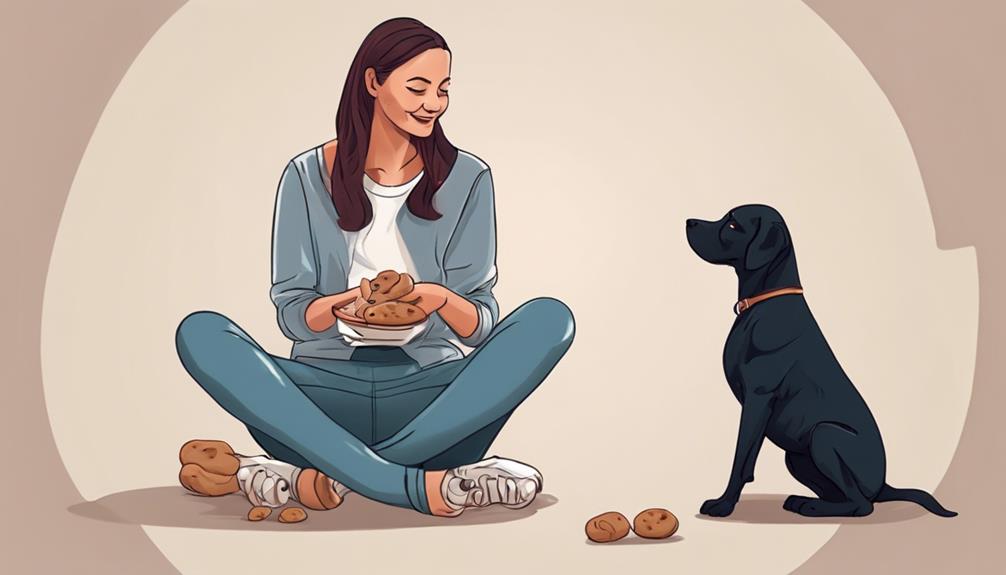5 Best Ways to Comprehend Your Dog's Mindset
Understanding your dog's mindset is like deciphering a complex puzzle; it requires patience and keen observation. By grasping the subtle cues in your furry friend's behavior, you can unlock a deeper connection with them.
But what if there were specific techniques that could enhance this bond even further? Stay tuned to uncover the five best ways to comprehend your dog's mindset and strengthen your relationship with man's best friend.
Canine Body Language
Understanding your dog's emotions through their body language can greatly enhance your bond with them. Dogs use communication cues and behavioral signals to express themselves, and being able to interpret these can lead to a deeper connection with your furry friend.
One common communication cue is tail wagging. While many interpret this as a sign of happiness, it can also indicate other emotions like anxiety or insecurity depending on the wag's speed and height. Similarly, a relaxed body posture with ears perked up usually signifies a friendly and approachable demeanor. On the other hand, a tense body with lowered ears might indicate fear or aggression.
Pay attention to your dog's facial expressions too. A relaxed mouth and soft eyes often convey contentment, while a wrinkled forehead or bared teeth can signal discomfort or aggression. By understanding these subtle cues, you can better respond to your dog's needs and strengthen your bond through improved communication.
Socialization and Behavior
To effectively socialize your dog and shape their behavior, expose them to various environments, people, and animals from an early age. This early exposure helps them become well-adjusted and confident in different situations.
Canine playtime is crucial during socialization, as it allows puppies to learn appropriate interaction with other dogs, developing their social skills and communication. Encouraging positive experiences during this time can prevent future behavioral issues, such as fear or aggression towards unfamiliar people or animals.
When socializing puppies, ensure that the environments they're introduced to are safe and positive. Gradually expose them to new stimuli, rewarding calm and confident behavior. Positive reinforcement, such as treats or praise, can help reinforce good behavior and create positive associations with new experiences. Additionally, supervised interactions with other dogs can teach them appropriate play behavior and communication cues.
Remember that socialization is an ongoing process that should continue throughout your dog's life. By prioritizing socialization and positive experiences, you can help shape your dog's behavior and foster a well-rounded and sociable companion.
Understanding Canine Emotions
When observing your dog's behavior, pay attention to subtle cues that reveal their emotional state. Your furry friend mightn't be able to communicate with words, but their body language speaks volumes. Understanding canine emotions requires a certain level of emotional intelligence and knowledge of canine psychology.
Dogs experience a wide range of emotions, including happiness, fear, sadness, and anxiety. Just like humans, they can feel joy when playing with their favorite toy or exhibit fear when encountering something unfamiliar. By observing your dog closely, you can pick up on these emotional cues and respond accordingly.
Canine psychology plays a crucial role in understanding your dog's emotional state. Dogs have their own unique personalities and ways of expressing themselves. By familiarizing yourself with basic canine psychology principles, you can better comprehend why your dog acts a certain way in different situations.
Training Techniques for Dogs
Use positive reinforcement techniques to train your dog effectively and foster a strong bond between you and your furry companion. Positive reinforcement involves rewarding your dog for good behavior rather than punishing them for mistakes. This method encourages your dog to repeat desired behaviors because they associate them with positive outcomes. One popular positive reinforcement technique is clicker training. With clicker training, you use a clicker to create a distinct sound that marks the exact moment your dog does something right, followed by a reward. This helps your dog understand precisely what they did to earn the reward, making the training process clearer and more efficient.
Consistency is key when using positive reinforcement. Make sure to reward your dog every time they exhibit the desired behavior to reinforce it effectively. Keep training sessions short and engaging to prevent your dog from getting bored or frustrated. Remember, training should be a positive experience for both you and your dog, strengthening your bond and creating a harmonious relationship based on trust and understanding.
Impact of Environment on Dogs
Creating a safe and stimulating environment is crucial for ensuring your dog's overall well-being and behavior. Environmental enrichment plays a significant role in keeping your furry friend happy and mentally engaged. By providing interactive toys, puzzle feeders, and regular exercise, you can prevent boredom and destructive behaviors in your dog. Additionally, setting up a designated space with cozy bedding and comforting items can offer a sense of security.
Understanding stress triggers is essential to maintaining a positive environment for your dog. Loud noises, changes in routine, or being left alone for extended periods can all contribute to stress. Behavior modification techniques such as desensitization and counterconditioning can help your dog cope with these stressors effectively. Calming techniques like providing a safe retreat, using calming pheromones, or playing soothing music can also aid in creating a peaceful environment for your furry companion.
Recognizing Stress in Dogs
Recognizing stress in your dog is crucial for addressing their well-being and behavior effectively. Dogs can exhibit various anxiety signals when they're under stress. These signs may include excessive barking, panting, pacing, trembling, yawning, or avoiding eye contact. It's important to pay attention to these cues as they can indicate that your furry friend is feeling overwhelmed or anxious.
Managing stress triggers is essential to help your dog feel more comfortable and secure. By identifying what situations or stimuli cause stress in your dog, you can work on gradually desensitizing them to those triggers. For example, if your dog gets anxious around loud noises, you can introduce gradual exposure to sounds in a controlled environment to help them become more at ease.
Building Trust and Bonding

To foster a strong connection with your dog, prioritize building trust and bonding through consistent positive interactions. Trust exercises can help strengthen the bond between you and your furry companion. Engage in activities that require teamwork, such as teaching your dog to follow commands or solving puzzles together. By working together in a positive and rewarding manner, you can establish trust and deepen your relationship.
Bonding activities are another essential aspect of building a strong connection with your dog. Spend quality time together engaging in activities that your dog enjoys, such as going for walks, playing games, or simply cuddling on the couch. These shared experiences create a sense of togetherness and strengthen the emotional bond between you and your dog.
Mental Stimulation for Canines
To keep your dog mentally engaged and fulfilled, incorporate activities that stimulate their cognitive abilities and problem-solving skills. Interactive toys and puzzle games are excellent tools to challenge your canine companion's mind and provide entertainment. Here are five ways to provide mental stimulation for your dog:
- Interactive Toys: Invest in toys that dispense treats when manipulated, encouraging your dog to think and strategize.
- Puzzle Games: Introduce puzzle games that require your dog to solve problems to access hidden treats, keeping them mentally active.
- Hide and Seek: Hide treats around the house or yard for your dog to find, engaging their sense of smell and cognitive skills.
- Training Sessions: Regular training sessions not only reinforce good behavior but also stimulate your dog's mind by learning new commands and tricks.
- Scent Work: Engage your dog in scent work activities where they've to sniff out specific scents, providing mental exercise and fulfillment.
Frequently Asked Questions
How Do Dogs Perceive Time Compared to Humans?
When it comes to time perception, dogs and humans have cognitive differences.
Dogs perceive time differently than you do. Their sense of time is more connected to routines and events rather than hours and minutes.
They live in the moment and don't dwell on past or future like humans.
Understanding this difference can help you communicate better with your furry friend and build a stronger bond based on their unique perception of time.
Do Dogs Have a Sense of Humor?
Dogs can have a sense of humor, although it may not be exactly like humans. They can laugh in their own way, displaying joy and amusement.
Understanding dog emotions is key to recognizing when they're being playful or funny. While they may not intentionally play jokes like humans do, dogs can engage in behaviors that seem mischievous or humorous to us.
Exploring canine behavior can reveal the lighter side of your furry friend's personality.
Can Dogs Experience Jealousy?
Dogs are capable of experiencing jealousy, just like humans. Canine emotions and behavior can show signs of envy when they feel another pet or person is getting more attention or treats.
This emotion can manifest through behaviors like aggression, attention-seeking, or trying to disrupt interactions.
It's important to understand and address these feelings to maintain harmony in your furry friend's life and prevent any negative outcomes.
Are There Certain Types of Music That Can Calm Dogs Down?
Certain types of music can have calming effects on dogs, influencing their behavioral responses. Musical preferences vary among dogs, but classical music or soft melodies are generally soothing. These sounds can impact canine psychology, promoting relaxation and reducing stress levels.
Experiment with different genres to find what works best for your furry friend. Remember, music can play a significant role in creating a peaceful environment for your dog.
Do Dogs Dream When They Sleep?
When dogs sleep, their brain activity mirrors that of humans in the REM stage, indicating they likely dream during this phase. Dream analysis in dogs is challenging, but their sleep patterns suggest dreaming is probable.
Canine behavior, such as twitching paws or making noises while asleep, supports the idea that dogs experience dreams.
Conclusion
Now that you have learned the best ways to comprehend your dog's mindset, you can strengthen your bond and communication with your furry friend.
By understanding their body language, emotions, and behavior, you can create a positive environment for them to thrive in.
Through proper training techniques, socialization, and mental stimulation, you can ensure your dog is happy and healthy.
Remember to always pay attention to their needs and build trust through love and care.
